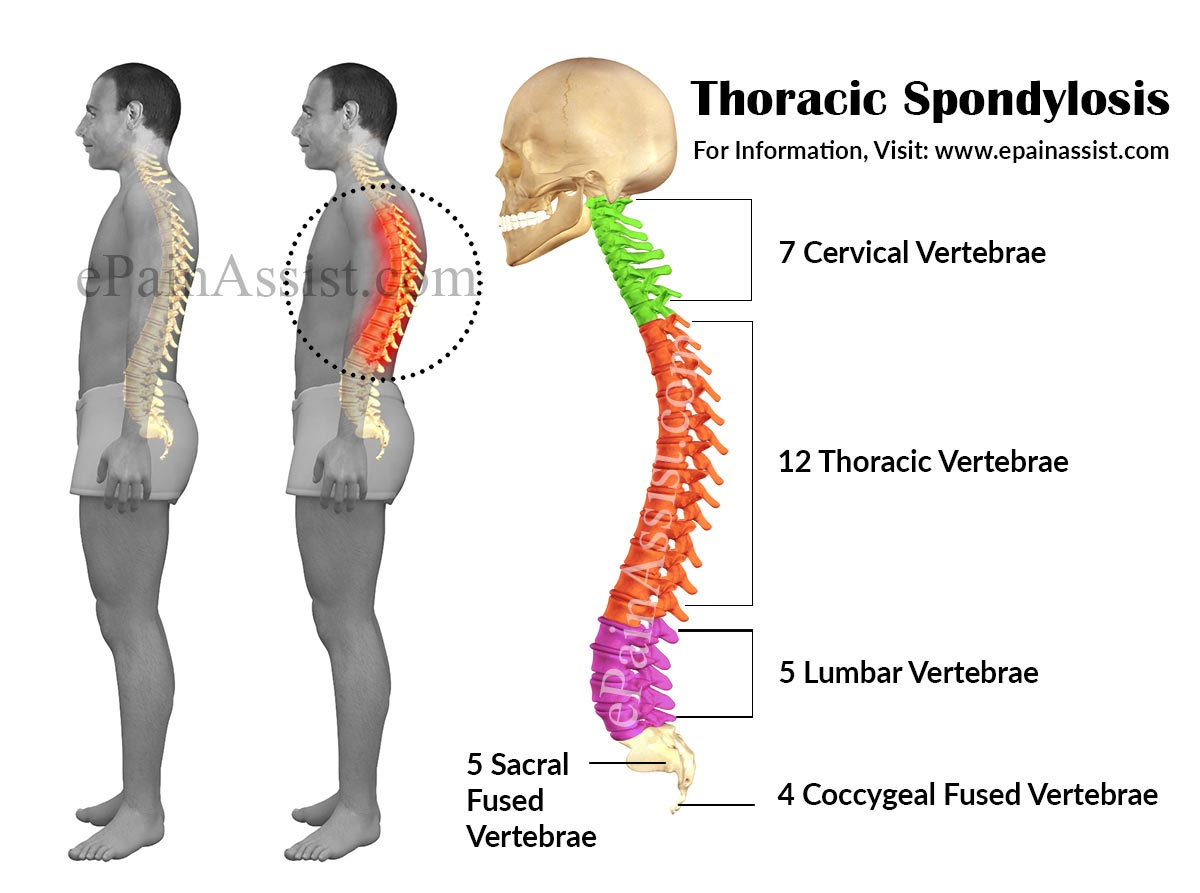Spine pain or back pain is one of the most common types of pain that an individual suffers during middle age and above the age of 45 years. The cause of the back pain is basically degeneration of the spine due to age or normal wear and tear following strenuous activities resulting in degeneration of the bones, ligaments and disc. The disease is seen especially in cervical and lumbar spine. Most of the movements of the vertebral column are observed in cervical and lumbar vertebrae. Apart from the cervical and lumbar spine, the thoracic spine also gets degenerated as a result of age. Though thoracic spine degeneration is not as common as the cervical and lumbar spine degeneration1, thoracic spine degeneration is predominantly caused by age related factors and very seldom results from normal wear and tear. The painful condition of mid-back is known as Thoracic Spondylosis. In this article, we will discuss about Thoracic Spondylosis in detail.

How Do We Define Thoracic Spondylosis?
Thoracic Spondylosis is not as common as cervical or spinal spondylosis, but is a medical condition of the upper back that generally affects people above the age of 45. Thoracic Spondylosis is a degeneration of the soft tissues of the thoracic spine.1, 2 As our body ages, due to natural chemical changes in the body; there is dehydration of the cartilaginous pads cushioning the vertebrae also known as the discs. Due to the normal aging process, these discs start becoming weak and hence become sensitive to normal stresses put on the spine. Due to this breakdown, painful conditions of the spine develop, of which Thoracic Spondylosis is a condition. In Thoracic Spondylosis, the ligaments and tendons of the thoracic spine dry out and get narrowed resulting in misalignment of the bones of the thoracic spine. Thoracic Spondylosis can also result in spinal stenosis.
Causes of Thoracic Spondylosis
Age is the main cause of Thoracic Spondylosis. Majority of the cases of Thoracic Spondylosis develop in individuals who are above the age of 45. Due to the normal aging process, the discs in the spine start wearing out and become brittle. This may result in tearing of the discs or make the discs extremely weak. These brittle and stiff discs may become small or protrude out from their usual place and cause undue strain or pressure in the joints and tissues in the area resulting in pain.
Symptoms Of Thoracic Spondylosis
Since the function of the thoracic spine is not as cumbersome as the cervical and lumbar spine, Thoracic Spondylosis develops as an after effect of degeneration of the spine at another location, but this is not always the scenario. Some of the common symptoms of Thoracic Spondylosis are:
- Pain in the upper back, especially in the morning when getting up.
- Stiffness of the mid back or the upper back.
- Numbness and tingling of the upper and lower extremities.
- Weakness of muscles
- Discoordination
- Trouble ambulating
Diagnosis For Thoracic Spondylosis
Specialists that need to be consulted for Thoracic Spondylosis are Neurosurgeons, Physiatrist specialist, or a Spine Surgeon. Thoracic Spondylosis can be diagnosed by conducting the following tests and studies:
Examinations for Thoracic Spondylosis
- The physician will take a thorough history and conduct a detailed physical examination of the spine observing for symptoms.
- Imaging studies like x-rays, CT scan or an MRI of the thoracic spine may be ordered for confirmatory diagnosis and to look at the degree of degeneration of the thoracic spine.
Treatment For Thoracic Spondylosis
The treatment of Thoracic Spondylosis depends on the degree of degeneration of the thoracic spine and the symptoms experienced by the individual.
Conservative Approach To Treat Thoracic Spondylosis3–
- Rest
- Exercise
- Back Braces
- Heat and infra red light treatment
- Ultraviolet Therapy
- Heal Therapy
- Acupuncture
- Chiropractic Therapy.
Medications to Treat Thoracic Spondylosis-
Nonsteroidal Anti-inflammatory Medications (NSAIDs) for Thoracic Spondylosis
- Control pain
- Treat Inflammation
- Medications prescribed are Motrin, Naproxen and Celebrex.
Muscle Relaxants for Thoracic Spondylosis
- Prescribed for muscle spasm
- Helps in optimizing physical therapy
Physical therapy (PT)3 To Treat Thoracic Spondylosis
- Treat pain
- Strengthen the spine muscles.
Prognosis Of Thoracic Spondylosis
The general prognosis for people with Thoracic Spondylosis is generally good at least for partial recovery from symptoms.
References
1. Lower thoracic degenerative spondylithesis with concomitant lumbar spondylosis.
Hsieh PC1, Lee ST1, Chen JF2.
Clin Neurol Neurosurg. 2014 Mar;118:21-5. doi: 10.1016/j.clineuro.2013.11.019. Epub 2013 Dec 6.
2. Spondylolisthesis of the thoracic spine. Case report.
Shimada Y1, Kasukawa Y, Miyakoshi N, Hongo M, Ando S, Itoi E.
J Neurosurg Spine. 2006 May;4(5):415-8.
3. Nonoperative treatment of symptomatic spondylolysis.
Kurd MF1, Patel D, Norton R, Picetti G, Friel B, Vaccaro AR.
J Spinal Disord Tech. 2007 Dec;20(8):560-4.
